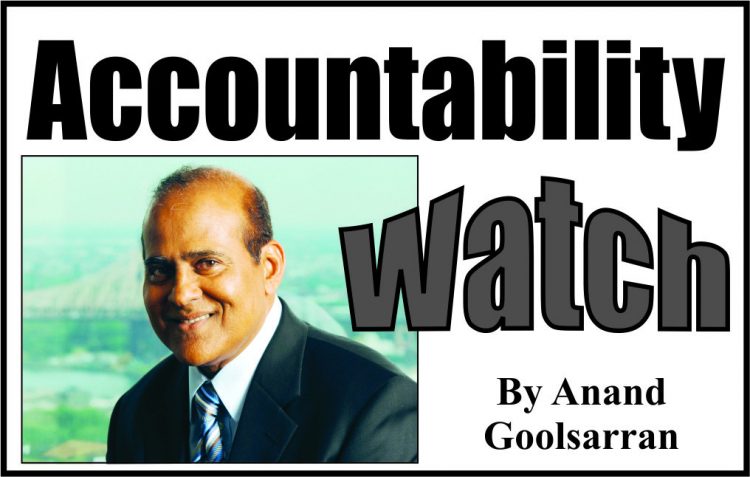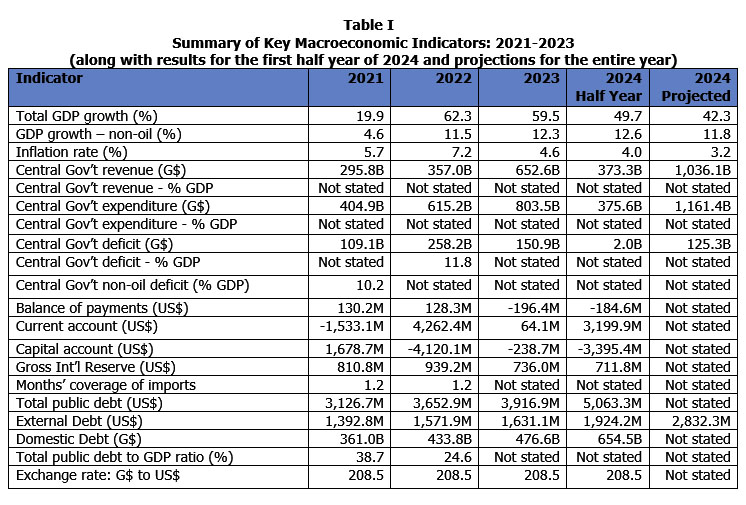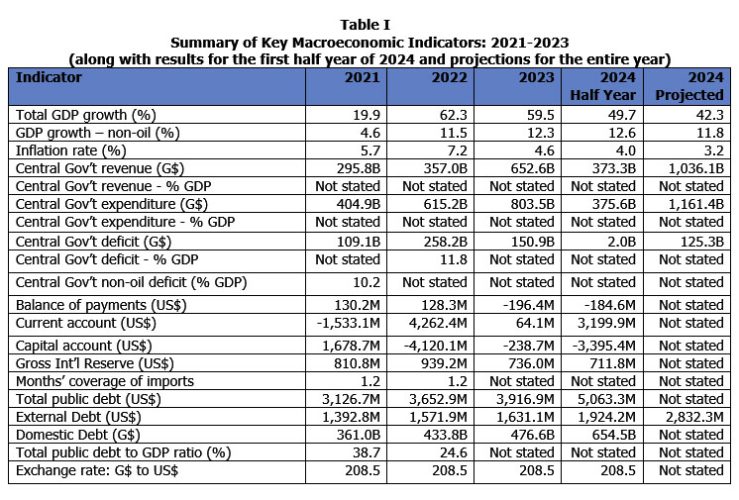 There we go again. On the heels of the discovery of 4.4 tonnes of cocaine neatly packed and concealed in pits near an illegal airstrip in Matthews Ridge, allegations of corruption have surfaced in the last week in least at two State agencies – Guyana Marketing Corporation and the Mahaica-Mahaicony-Abary Agricultural Development Authority (MMA/ADA). In relation to the former, the General Manager has reportedly stated that she noted discrepancies between the information provided by the accountant and that of the Special Projects Manager and that it was she who initiated the investigation, and not the Ministry of Agriculture. The main issue relates to allegations of smuggling of chicken and eggs into the country, the details of which are sketchy.
There we go again. On the heels of the discovery of 4.4 tonnes of cocaine neatly packed and concealed in pits near an illegal airstrip in Matthews Ridge, allegations of corruption have surfaced in the last week in least at two State agencies – Guyana Marketing Corporation and the Mahaica-Mahaicony-Abary Agricultural Development Authority (MMA/ADA). In relation to the former, the General Manager has reportedly stated that she noted discrepancies between the information provided by the accountant and that of the Special Projects Manager and that it was she who initiated the investigation, and not the Ministry of Agriculture. The main issue relates to allegations of smuggling of chicken and eggs into the country, the details of which are sketchy.
As regards the MMA/ADA, the main opposition political party, Peoples National Congress Reform, issued a statement alleging that there is a “massive corruption scheme” perpetrated by several staff members of the Authority in collusion with contractors regarding payments for works not undertaken or for overvalued works. The party also referred to the alleged land-grabbing and misuse of the machinery, fuel, staff, and other malpractices levelled against a senior official of the MMA/ADA. Only recently, the Authority was in receipt of supplementary estimates totalling $60 million to assist it with its operational costs. This is in addition to amounts of $473 million and $250 million reflected in the 2024 Estimates as subsidies and infrastructure developments work, respectively.
According to the 2022 Auditor General’s report, the accounts of the MMA/ADA were last audited to 2010 and therefore the Authority was 12 years in arrears in terms of financial reporting and audit. It continues to boggle the mind how legislators could approve of funding/additional funding for State institutions that display a complete lack of accountability for their financial stewardship. And what of the Board of Directors of the MMA/ADA? During the period 1985-1987 when I served as Manager (Finance), on the last day of the month staff remained after working hours to close the books after which the financial statements were extracted. The Board met on a quarterly basis, and a complete set of financial statements for the period under review was presented to it.
At that time, the Chairman of the Board was the late President Desmond Hoyte, a disciplinarian of the highest order. Two weeks after I joined the Authority I attended a Board meeting. Mr. Hoyte posed a question to me relating to the collection of drainage and irrigation charges and land rent. Unable to provide a satisfactory answer, I stated that I was just appointed to the position. Mr. Hoyte got very angry, looked at me and in a firm voice said: ‘Look young man, if you were appointed a minute ago, you are responsible’! The other members included top public servants – the late Clyde Roopchand (Chief Planning Officer), the late Raymond Latchmansingh (Chief Hydraulics Officer), John Browman (Permanent Secretary of the Ministry of Agriculture), T. A. Earle (Commissioner of Landa and Surveys) and Dr. Howard London (Chief Medical Officer). The management staff were all technically and professionally qualified and experienced individuals. They included Ben Carter (General Manager), James Woolward (Chief Administration Officer), Colin Forsythe (Engineering Services), Bristol Carter (Agriculture), Roy Budhram (Lands), Herman Sealey (Projection Execution Unit), Lindsay Bascom (Chief Accountant) and Lynette Williams (Accountant). During this period, there was never a hint of mismanagement of resources, corruption or fraud, and there was up-to-date financial reporting and audit of the Authority’s books. We were also able to overhaul the accounts of the Authority to bring them in line with international accounting standards.
According to former Finance Minister, Winston Jordan, if the Government cuts various types of “waste” by at least 10 percent, there will be enough money to pay teachers a 20 percent increase in 2024, 15 percent in 2025 and 10 percent in 2026. The waste to which he referred includes ‘shoddy public infrastructure projects, corruption, political projects for votes, improper maintenance, waste of public money and absence of feasibility studies’. Mr. Jordan also advocated the reintroduction of performance appraisal for public servants, teachers, nurses and other government employees to be used as a basis for determining salary increases instead of the across-the-board increases that reward good performance, mediocre performance and poor performance with the same quantum of increases. The latter provides no incentive for employees to give of their best and to rise to the highest level of their potential.
The former Minister further stated that there is no need to increase taxes to pay higher wages and salaries and that the Guyana Revenue Authority (GRA) needs to go after thousands of self-employed persons who pay little or no taxes. While we agree wholeheartedly with the views expressed by the former Minister, we might add, as we have done on several occasions before, that the GRA needs to conduct lifestyle audits to ascertain whether the income and net assets declared by those who are flaunting unexplained wealth, match their tax returns.
In our last two articles, we provide highlights of the recently compiled 2024 Mid-Year report on the execution of the annual budget and the performance of the economy. In today’s article, we take a closer look at the report. Based on the report and other documents, we compiled Table I which we reproduce below:
Real GDP Growth
As noted, the total real Gross Domestic Product (GDP) growth for the first half of 2024 was 49.7 percent, with non-oil growth accounting for 12.6 percent. We, however, continue to advocate caution in interpreting the former as an indicator of real progress, considering that for every 100 barrels of oil produced, Guyana gets only 12.5 barrels. In this regard, a more appropriate measure of economic and social progress could be to include only Guyana’s share of the growth in oil production to which is added the non-oil growth, as follows: (37.1 x 12.5%) + 12.6% = 16.2 percent. We would love to hear from the trained economists on the merit of such a simple calculation, or on any alternative calculation they may wish to propose. We again refer to the most recent assessment by the World Bank of Guyana’s income status where it was stated that nearly 50 percent of the population lives on less than US$5.50 per day. This suggests that the effect of the oil revenues has so far had little or no impact on the lives of ordinary citizens.
Inflation
The criticism of the reported rate of inflation of 4.0 percent for the 12-month ended 30 June 2024, and more especially the increase in consumer price index of 1.6 percent over the same period, has been so vociferous that it leads one to believe that they bear little or no relationship of the situation on the ground, especially when one takes into account the spiralling cost of living. The public sector monthly minimum wage is G$75,000, equivalent to US$360 at the official exchange rate of US$1=G$208.5, while that of the private sector is G$60,000, equivalent to US$288.
It boggles the mind how are these workers able to survive on such meagre wages. And what of the unemployed youth, single-parent families, the sick and the elderly, pensioners and other disadvantageous groups? In comparison, Trinidad and Tobago’s monthly minimum wage is TT$3,553, equivalent to US$523 which is almost twice the amount paid to Guyana’s private sector workers. In Jamaica, which is not an oil-producing country, the monthly minimum is J$60,000, equivalent to US$384.
Budget execution – expenditure
The 2024 Estimates of Revenue and Expenditure showed as amount of $1.146 trillion appropriated to meet the cost of executing government programmes and activities to which must be added two Supplementary Estimates totalling $40.8 billion. According to the report, amounts totalling $375.6 billion were expended in the first half of the year, representing an overall 32.8 percent achievement on the budget. Current expenditure recorded a 42.8 percent achievement, with amounts totalling $205.4 billion expended out of a total budgetary allocation of $479.7 billion. On the other hand, capital expenditure was $162.9 billion, representing 24.5 percent of the total budgetary allocation of $666.2 billion.
At this rate, by the end of the year, only two-thirds of the total budget will be executed. It has been the practice over the years for expenditure to be accelerated in the last quarter of the year to exhaust budgetary allocations. In particular, there was evidence of contracts being entered into in late December and in some cases on the last working day of December, and cash books being kept open well into the new year to facilitate the issuing of cheques. This is a clear violation of the Fiscal Management and Accountability Act that requires all unspent balances on appropriations at the end of the fiscal year to be refunded to the Consolidated Fund. Because of these violations, all sorts of breaches and irregularities have occurred in the past, including significant breaches in the tendering procedures relating to the procurement of goods/services and the execution of works; defective work performed; and overpayments to suppliers/contractors, goods/services not delivered for which payments have been made.
Budget execution – revenue
Current revenue for the first half of the year amounted to $227.2 billion, representing a 31.7 percent achievement of the budgeted amount of $717.8 billion. At this rate, only 63.4 percent of the estimated revenue collections will be achieved unless there is an intensification of efforts. As regards withdrawals from the Natural Resource Fund (NRF), which amounted to $114.4 billion for the first half of the year, we continue to argue that the amounts withdrawn should not be treated as current revenue but rather capital revenue to be matched with capital expenditure. The NRF Act specifically states that all such withdrawals are to be made to finance:
(a) National development priorities including any initiative aimed at realizing an inclusive green economy; and
(b) Essential projects that are directly related to ameliorating the effect of a major disaster.
Capital revenue collections, derived mainly from the proceeds of loans and grants, amounted to $116.5 billion, representing a 50.8 percent achievement on the annual budget of $229.3 billion.
-To be continued –










